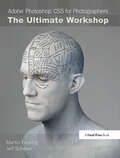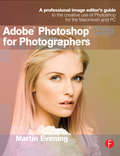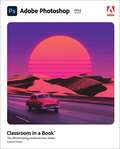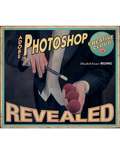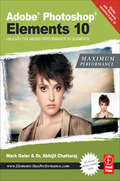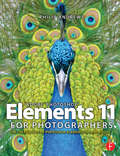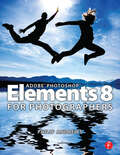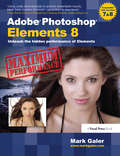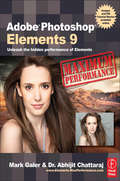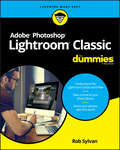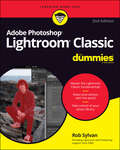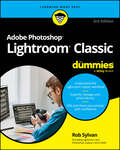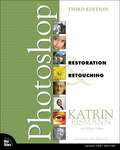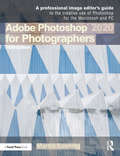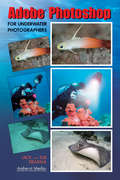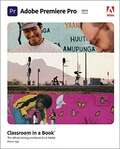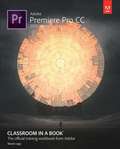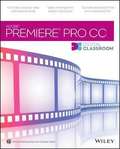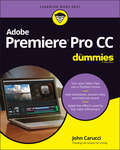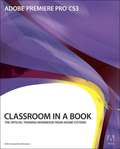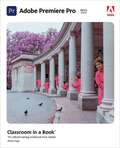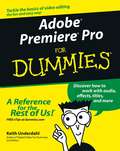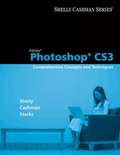- Table View
- List View
Adobe Photoshop CS5 for Photographers: The Ultimate Workshop
by Martin Evening Jeff ScheweIf you already have a good knowledge of Adobe Photoshop and are looking to advance your skills, Adobe Photoshop CS5 for Photographers: The Ultimate Workshop is the book you've been waiting for. Renowned photographers Martin Evening and Jeff Schewe impart their Photoshop tips and workflow, showing you how to use a vast array of rarely seen advanced Photoshop techniques. Whether the subject is serious retouching work, weird and wonderful compositions, or planning a shoot before you've even picked up a camera, you can be sure that the advice is based on years of practical experience.Full of inspirational photographs and hundreds of full-color screenshots to show you how it's done, this book features:-Advice on becoming a retouching master with advanced masking and compositing techniques-A detailed workflow for preparing your images for the best possible output, showing you how to meet both deadline and budge without sacrificing quality-26 movie tutorials on the downloadable resources, offering over 3 hours of movie contentThe ideal companion to Photoshop CS5 for Photographers, this is a must-have resource for any serious user of Adobe Photoshop.
Adobe Photoshop CS6 for Photographers: A professional image editor's guide to the creative use of Photoshop for the Macintosh and PC
by Martin EveningRenowned Photographer and Photoshop hall-of-famer, Martin Evening returns with his comprehensive guide to Photoshop. This acclaimed work covers everything from the core aspects of working in Photoshop to advanced techniques for refined workflows and professional results. Using concise advice, clear instruction and real world examples, this essential guide will give you the skills, regardless of your experience, to create professional quality results. A robust accompanying website features sample images, tutorial videos, bonus chapters and a plethora of extra resources. Quite simply, this is the essential reference for photographers of all levels using Photoshop.
Adobe Photoshop Classroom In A Book (Classroom In A Book Ser.)
by Conrad ChavezLearn to create and edit images using Adobe Photoshop Adobe Photoshop Classroom in a Book (2023 release) uses real-world, project-based learning to cover the basics and beyond, providing countless tips and techniques to help you become more productive with the program. For beginners and experienced users alike, you can follow the book from start to finish or choose only those lessons that interest you. Learn to: Correct and improve digital images Seamlessly remove backgrounds, repair images, and replace skies Explore advanced filters that use machine learning and cloud processing Select subjects with complex outlines, including hair, quickly and precisely Composite multiple images and combine with typography Edit video, including transitions and motion effects Edit camera raw images Automate tasks Save as a Photoshop cloud document to easily edit across desktop and mobile devices Export your work for web, mobile devices, and print Classroom in a Book®, the best-selling series of hands-on software training workbooks, offers what no other book or training program does―an official training series from Adobe, developed with the support of Adobe product experts. Purchasing this book includes valuable online extras. Follow the instructions in the book's "Getting Started" section to unlock access to: Downloadable lesson files you need to work through the projects in the book Web Edition containing the complete text of the book, interactive quizzes, and videos that walk you through the lessons step by step What you need to use this book: Adobe Photoshop (2023 release) software, for either Windows or macOS. (Software not included.) Note: Classroom in a Book does not replace the documentation, support, updates, or any other benefits of being a registered owner of Adobe Photoshop software. This book covers Photoshop on desktop only. It does not address Photoshop on the iPad.
Adobe Photoshop Creative Cloud Revealed
by Elizabeth Eisner RedingAdobe Photoshop has long provided cutting edge technology for sophisticated digital editing, and ADOBE PHOTOSHOP CREATIVE CLOUD REVEALED provides a solid foundation for those looking to learn this industry-standard program. Real-world, practical examples and step-by-step instruction throughout offer well-rounded, comprehensive coverage of both artistic and technical features. With extensive four-color artwork and screenshots that support and clarify key concepts, ADOBE PHOTOSHOP CREATIVE CLOUD REVEALED is a valuable resource that will give readers the confidence they need to edit and enhance digital images with skill and ease.
Adobe Photoshop Elements 10: Unleash the hidden performance of Elements
by Mark Galer Abhijit ChattarajMaster the most powerful photo editing tools and techniques that Elements has to offer! Using step-by-step projects, Mark Galer will have you creating stunning images in no time at all. Whether you want to create impressive, seamless montages, optimize your photos for perfect print quality, or simply enhance your images for maximum impact, Maximum Performance will give you the skills and know-how you need to create professional quality results. Featured projects teach you how to work with multilayered 16 bit/channel files, as well as convert to black and white using Adobe Camera Raw, create High Key images, work with image borders and textures, and create tilt-shift and cross-process effects. Three movie tutorials featuring specific techniques from the book are available for free online, and a supplemental package of images and movies can be purchased with an easy one-time download from the authors' website, www.elements-maxperformance.com. Find everything you need to unleash the power of Elements with Max Performance, or for a more interactive learning experience, download the supplemental images and movies for comprehensive, hands-on learning.
Adobe Photoshop Elements 11 for Photographers: The Creative Use of Photoshop Elements
by Philip AndrewsTo coincide with some of the biggest changes in Photoshop Elements for years, Philip Andrews completely revises his bestselling title to include all the new features of this release. See how the new interface works alongside new tools, techniques and workflows to make editing, enhancing and sharing your pictures easier than ever. And as always, he introduces the changed and improved features with colorful illustrations and the clear step-by-step instruction that has made his books the go-to titles for photographers the world over. In this edition Andrews highlights the following new features: Interface for both the Editor and Organizer Revel integration in Organizer New tools in the Quick Editor workspace Changes to the Actions palette Pen and Ink, Comic and Graphic Novel filters Vignette, Tilt-Shift, High Key, and Low Key Guided Edit effects Places, People and Events Organizer work modes Changes for Adobe Camera Raw Supercharged folder view Online content The Task bar Exposure and Vibrance sliders in Quick Edit At the same time, Andrews provides a comprehensive overview of the most used tools and techniques in the rest of the program. Readers also benefit from a being able to access book resources and instructional videos at the associated website photoshopelements.net. They can also extend their learning with the special Photoshop Elements for Photographers app available from the Apple App Store.
Adobe Photoshop Elements 8 for Photographers
by Philip AndrewsA complete reference guide for all levels of photographers who use Adobe Photoshop Elements.
Adobe Photoshop Elements 8: Unleash the hidden performance of Elements
by Mark GalerUsing a unique combination of step by step projects, movie tutorials and sample images, Mark Galer guides the reader through the most powerful photo editing tools that Elements has to offer. Discussing and demonstrating the skills and know-how to create professional-quality results with this budget-priced software. Whether optimizing photographs for printing, enhancing images for maximum impact, or creating impressive, seamless montages, this book will enable any aspiring digital professional to get the maximum performance from the credit crunch approved software.The package is completed with astonishingly comprehensive downloadable resources packed with over 7 hours of movie tutorials, 100+ sample images, a stock photo gallery as well as automated actions to get even more out of the software.
Adobe Photoshop Elements 9: Unleash the hidden performance of Elements
by Mark GalerLet Mark Galer guide you through the most powerful photo editing tools and techniques that Elements has to offer! A unique cominbtion of step-by-step projects, movie tutorials and sample images will have you creating stunning images in no time at all. Whether you want to enhance your images for maximum impact, optimize your photos for perfect print quality, or creating impressive, seamless montages, Maximum Performance will give you the skills and know-how to create professional quality results, enabling you get maximum performance from this credit crunch approved software. The package is completed with an astonishingly supportive website packed with over 7 hours of movie tutorials, 100+ sample images, multimedia content and stock photography as well as automated actions to get even more out of the software.
Adobe Photoshop Flash & Dreamweaver CS5 Web Design Portfolio
by Erika RendraAdobe Photoshop is the industry-standard application for working with pixels — both manipulating existing ones and creating new ones. Many Photoshop experts specialize in certain types of work. Photo retouching, artistic painting, image compositing, and color correction are only a few types of work you can create with Photoshop. Our goal in this book is to teach you how to use the available tools to succeed with different types of jobs that you might encounter in your professional career.
Adobe Photoshop Lightroom Classic For Dummies
by Rob SylvanEdit, organize, store, and share photos Whether you are brand new to photography, a devoted enthusiast, or a seasoned pro, there’s a version of Lightroom for you. Lightroom For Dummies is the book to help you learn which version of Lightroom is right for your needs. The main focus of the book is on using Lightroom Classic, but also includes an introduction to Lightroom CC. All with the goal of helping you get started on the right foot toward taking your photographic workflow to the next level. The book is a great starting place to help you improve your family photos or add advanced Lightroom skills that aid your career. Look inside to find the steps to navigating the software and getting top-notch results. Deciding which version of Lightroom is the best fit Take control of your photo library with Lightroom Classic Importing, organizing, and finding photos Editing and sharing your photos Producing a slideshow, book, print, or web gallery Gain a foundation for getting started with Lightroom CC Get ready to spend less time in front of the computer and more time behind the lens!
Adobe Photoshop Lightroom Classic For Dummies
by Rob SylvanLearn to make your digital photos *pop* with easy-to-follow help using AI-powered software from Adobe With no prior photography or editing experience necessary, Adobe Photoshop Lightroom Classic For Dummies delivers a must-have walkthrough for taking your photos to the next level using Adobe’s powerful consumer software. You’ll learn the fundamentals of opening your pictures, managing your photo library, and fixing common problems—like redeye and poor lighting—before jumping into more advanced topics, like creating slideshows and troubleshooting problems. The perfect place to begin learning how to improve your family photos, Adobe Photoshop Lightroom Classic For Dummies also helps you discover: How to take control of and organize your photo library How to apply common artificial intelligence-powered photo enhancements with the click of a mouse Ways to share your photos with the world, both digitally and on paper The premier jumping-off point for aspiring photo editors everywhere, this book is a can’t-miss resource for anyone who wants to make the most of their digital photo collection and for professionals who want to expand their design skillset by learning Adobe Lightroom Classic.
Adobe Photoshop Lightroom Classic For Dummies
by Rob SylvanThe most up-to-date manual for using Adobe's gold standard photo workflow software Adobe Photoshop Lightroom Classic For Dummies is the perfect companion for photographers looking to make the most of this powerhouse software. Lightroom Classic lets you edit, organize, and share large volumes of digital photos, so you can spend less time in front of the computer and more time behind the lens. With this book, you'll learn the program's fundamentals and discover the latest features and updates'including improved Masking tools, AI-based tools, and the new Lens Blur feature. Discover the tools and processes that make the most sense for you, and get pro tips for taking your photos to the next level. Learn your way around the Lightroom Classic interface Expertly manage your photo library Edit and share your photos with confidence Make your photos even better with new editing tools This popular Dummies guide is great for anyone who needs a primer on the essentials of Lightroom Classic for personal or professional use.
Adobe Photoshop Restoration & Retouching (Third Edition)
by Katrin Eismann Wayne PalmerThe third edition of Photoshop Restoration & Retouching has been reviewed, updated, and revised on every single technique to address the most important features in Adobe Photoshop CS2. This book is divided into three primary areas: Improving tone, contrast, exposure, and color; Removing dust and mold, and repairing damage; and Professional portrait and glamour retouching.
Adobe Photoshop for Photographers: 2020 Edition
by Martin EveningAdobe Photoshop for Photographers by acclaimed digital imaging professional Martin Evening has been revamped to include detailed instruction for all of the updates to Photoshop on Adobe’s Creative Cloud, including significant new features such as Cloud document saving, the new Content-Area Fill and the Texture slider and Depth Range Mask for Camera Raw. This guide covers all the tools and techniques photographers and professional image editors need to know when using Photoshop, from workflow guidance to core skills to advanced techniques for professional results. Using clear, succinct instruction and real-world examples, this guide is the essential reference for Photoshop users. The accompanying website has been updated with new sample images, tutorial videos, and bonus chapters.
Adobe Photoshop for Underwater Photographers
by Jack Sue DrafahlUsing the digital darkroom to perfect underwater images, this guide is loaded with tips on how to finesse, fine-tune, retouch, and enhance underwater film scans and digital images with Adobe Photoshop. This comprehensive look at the required setup for a digital darkroom outlines the necessary hardware, monitor calibration, and room lighting, in addition to providing a survey of the top editing tools and descriptions of the most tried-and-true correction techniques. Step-by-step instructions explain how to group underwater images for editing; approach corrections for images that require a multi-step enhancement process; and choose the right output options for printed images, video, slide shows, and Web viewing.
Adobe Premiere Pro (Classroom in a Book)
by Maxim JagoThe fastest, easiest, most comprehensive way to learn Adobe Premiere Pro Classroom in a Book®, the best-selling series of hands-on software training workbooks, offers what no other book or training program does―an official training series from Adobe, developed with the support of Adobe product experts. <p><p> Adobe Premiere Pro Classroom in a Book (2021 release) contains 17 lessons that cover the basics and beyond, providing countless tips and techniques to help you become more productive with the program. You can follow the book from start to finish or choose only those lessons that interest you.
Adobe Premiere Pro CC Classroom In A Book (2017 Release)
by Maxim JagoCreative professionals seeking the fastest, easiest, most comprehensive way to learn Adobe Premiere Pro CC (2017 release) choose Adobe Premiere Pro CC Classroom in a Book (2017 release) from Adobe Press. The 18 project-based lessons in this book show users step-by-step the key techniques for working in Premiere Pro. Learn to edit video in Adobe Premiere Pro CC 2017 and get the most out of your workflow. Take a project from beginning to end and learn to organize media, add audio, create transitions, produce titles, and add effects. Take your projects further by sweetening and mixing sound, compositing footage, adjusting color, using advanced editing techniques, managing projects, working with 360 video for VR headsets, exporting, and much more. The online companion files include all the necessary assets for readers to complete the projects featured in each chapter as well as ebook updates when Adobe releases new features for Creative Cloud customers. All buyers of the book get full access to the Web Edition: a Web-based version of the complete ebook enhanced with video and interactive multiple-choice quizzes. As always with the Classroom in a Book, Instructor Notes are available for teachers to download.
Adobe Premiere Pro CC Digital Classroom
by Agi Training Team Jerron SmithAdobe Premiere Pro lets you edit and create video for a variety of platforms. It provides you with the editing tools to express your creative ideas for video, film and online broadband delivery. It is also tightly integrated with other Adobe products such as Photoshop, Illustrator, and After Effects so that you can integrate graphics and special effects into your projects. The book is guiding you through each lesson while you work at your own speed to gain an understanding of essential skills.
Adobe Premiere Pro CC For Dummies
by CarucciWhen the filming stops, the real video production work begins Ever wonder how your favorite video creators regularly put out such slick content? They're probably using Adobe Premiere Pro CC, a go-to video production app for both professional and amateur video creators. Adobe Premiere Pro CC For Dummies walks you through each step of editing and producing slick and stylish videos that stand up to what the pros post. From transferring your digital movie files from your camera or phone to your computer all the way to uploading your latest creation to YouTube or the web, this book has the info you need to bring your ideas to life. If you're new to video production, you can begin at the beginning with the handbook's user-friendly guide to the basics of setting clips on the timeline and making them flow seamlessly. Or, if you've already got a few videos under your belt, you can skip right to the more advanced material, like special effects and handy tricks of the trade. You’ll also find: Instruction on joining video clips into a continuous final product, complete with transitions, special effects, and more Advice on improving sound, getting rid of color errors, and customizing the look of your videos with filters and aftereffects Straightforward guides to adding voiceovers and soundtracks to your videos So, if you're new to Adobe Premiere Pro CC—or digital video editing in general—Adobe Premiere Pro CC For Dummies is the first and last resource you'll need to start editing like a pro.
Adobe Premiere Pro CS3
by Adobe PressThe best-selling guide to Adobe's powerful digital video editing application, now fully updated to cover the newest version of Premiere Pro.
Adobe Premiere Pro Classroom In A Book (Classroom In A Book Ser.)
by Maxim JagoThe fastest, easiest, most comprehensive way to learn Adobe Premiere Pro Classroom in a Book®, the best-selling series of hands-on software training workbooks, offers what no other book or training program does―an official training series from Adobe, developed with the support of Adobe product experts. Adobe Premiere Pro Classroom in a Book (2022 release) contains 17 lessons that cover the basics and beyond, providing countless tips and techniques to help you become more productive with the program. You can follow the book from start to finish or choose only those lessons that interest you.
Adobe Premiere Pro For Dummies
by Keith UnderdahlAn essential resource for anyone who wants to get up and running with this popular video-editing application, from amateur and hobbyist filmmakers to professionals who want to explore the possibilities of editing on a PCExplains how to shoot good footage, get digital video onto a PC, set up a Premiere production studio, edit clips, add effects, work with audio, and output the finished product or share it onlineReleased day and date with the new software version, the book covers the latest Premiere features and improvementsKeith Underdahl, the author of Digital Video For Dummies (0-7645-4114-5) and other books on digital video, has broad experience as both an amateur videographer and professional video producer
Adobe Premiere Pro Power Tips: Secrets, Shortcuts, and Techniques
by Larry JordanStop wasting time! Let Larry Jordan’s Adobe Premiere Pro Power Tips power your editing. Whether you are migrating to Premiere Pro from other editing software, or you are a long-time Premiere editor, this must-have guide is packed with hundreds of bite-sized tips to get you up and running in no time. Written with humor and deep technical understanding, Jordan shows you the secrets, shortcuts, tips, and techniques you need to make the most of Premiere Pro. Like any professional production, the book starts with planning, then flows into scripting, shooting, logging, editing, audio mixing, and final output with hundreds of Power Tips covering Story, Prelude, Premiere, Audition and Adobe Media Encoder. These Power Tips will: * Speed your editing* Expand your knowledge* Wow your clients (and keep them coming back for more!) Visit the companion website (www.focalpress.com/9780415657075) to see video demonstrations that accompany this book.
Adobe® Photoshop® CS3: Comprehensive Concepts and Techniques
by Gary B. Shelly Thomas J. Cashman Joy L. StarksNIMAC-sourced textbook
